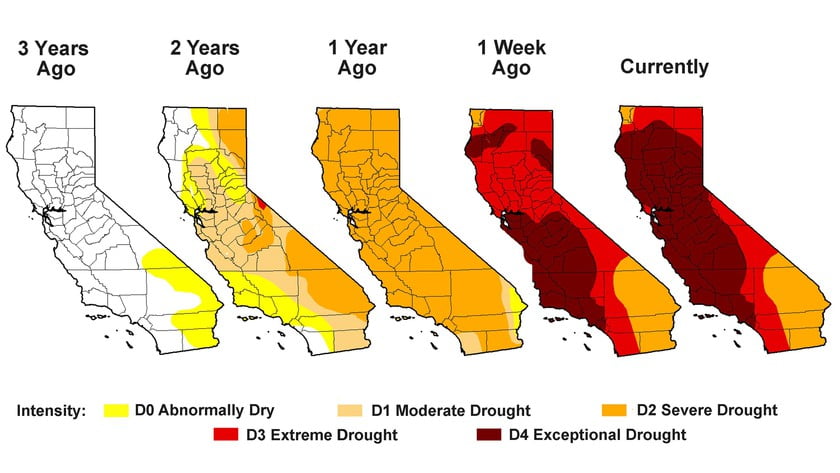There will be wars, famines and earthquakes. But all these things are merely the beginning of birth pangs.” (Matt. 24:4-8) Does famine affect earthquakes? Is there a relationship between Earthquakes and Drought?
Half of the United States is experiencing drought, according to the latest numbers from the U.S. National Drought Monitor. The drought is deepest in California and the Texas and Oklahoma panhandles, according to the latest drought map, released May 8.
Today, for the first time this century, the entire state of California is in a severe drought — or worse. The drought in California, the largest US agricultural producer, has exacerbated wild fires burning in the southern part of the state and might force some farmers to abandoned fields as lack of water makes it impossible to grow crops.
The three worst levels of drought are severe, extreme and exceptional: 100% of California is now in one of those three categories: (23.31% severe, 51.92.% extreme and 24.77% exceptional.) The most comparable recent drought was the drought of 1976-77. But the impacts today are more intense because the state’s population has doubled since then while the state’s water supply has remained fixed. The only other California drought similar to todays was during the 1920s. But the state’s population then was 1/10th of what it is now.
Through the first four months of 2014, California and Arizona have experienced the hottest start to any year in records going back to 1895.
 As if the drought couldn’t get any worse, geologists now think that changes in groundwater could be destabilizing the infamous San Andreas Fault. The new research presents “a grand unified theory of California problems: water and drought lead to earthquake risk.” The study published this week in Nature started with asking why the Sierra Nevada’s and Coastal Ranges have risen by 1 to 3 millimeters every year.
As if the drought couldn’t get any worse, geologists now think that changes in groundwater could be destabilizing the infamous San Andreas Fault. The new research presents “a grand unified theory of California problems: water and drought lead to earthquake risk.” The study published this week in Nature started with asking why the Sierra Nevada’s and Coastal Ranges have risen by 1 to 3 millimeters every year.
University of Nevada, Reno Research Professor Geoff Blewitt told this story in a presentation at the European Geophysical Sciences Union conference in Vienna, Austria on April 28. The annual EGU General Assembly is the largest and most prominent European geosciences event attracting over 11,000 scientists from all over the world.
Over the past 150 years, around 40 trillion gallons of groundwater in California’s Central Valley has been lost through pumping, irrigation and evapotranspiration. That’s roughly equal to all the water in Lake Tahoe, the volume of which can cover the entire state of California in 14 inches of water.
This groundwater is being increasingly depleted by agriculture in the Central Valley. The upper portion of the earth is elastic, and the ground water is weighing it down on it. Removing groundwater is like lifting that weight. The earth’s crust literally flexes up. As it moves up, it pushes up the Sierra Nevada’s and the Coastal Ranges. If the effect of groundwater depletion is big enough to move mountains, then it’s also big enough to affect the San Andreas Fault, where only friction keeps two tectonic plates from slipping. Changes in the balance of forces on these faults result in earthquakes. Long-term depletion of groundwater has led to the continued rise of the Sierra Nevada’s and it could be further destabilizing the San Andreas fault. The current drought has made it worse.
When Oklahoma actually outpaced California in total quakes during each of the first three months in 2014, researchers said they believed injection wells used to dispose of fracking wastewater were contributing to heightened earthquake activity. To unleash natural gas, fracking requires large volumes of water, sand, and chemicals to be pumped underground. The changes in pressure led to the swarms of quakes.
Seismologists grapple with the connection between oil and gas development and earthquakes. New research being presented at the annual meeting of the Seismological Society of America showed that wastewater disposal wells—deep holes drilled to hold hundreds of millions of gallons of fluid produced by oil and gas wells—may be changing the stress on existing faults, inducing earthquakes. Those quakes can occur tens of miles away from the wells themselves and can be large as well—researchers have now linked two quakes in 2011 with a magnitude greater than 5.0 to wastewater wells.
So we pump the water out to irrigate the land or we pump water in to extract the oil – nature has reached a tipping point. Earthquakes and famine are not two unrelated ideas. Given the recent wars over oil – Wars, earthquakes and famine are all very related. New wars will be fought over dwindling resources. The Author of these words knew what He was talking about. For nation will rise against nation, and kingdom against kingdom, and in various places there will be famines and earthquakes. But all these things are merely the beginning of birth pangs.” (Matt. 24:4-8)